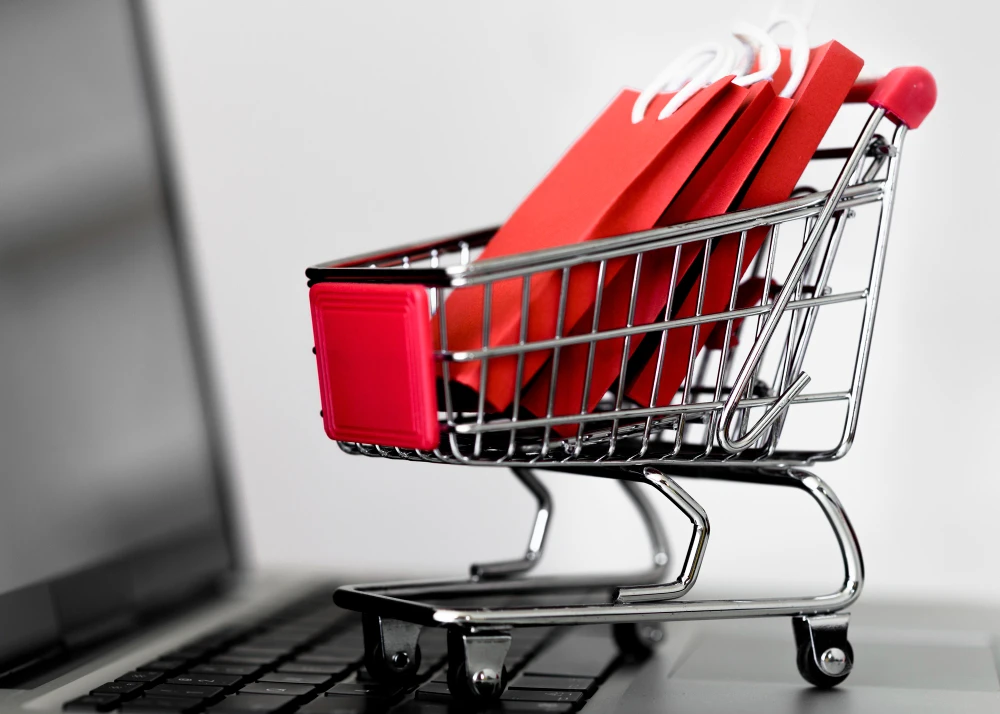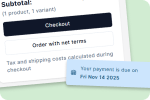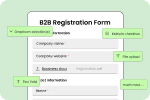B2B Ecommerce refers to the online sale of goods or services between businesses, in contrast to B2C Ecommerce where sales are directed to individual customers. The sector is expanding rapidly, with the US B2B Ecommerce market alone valued at over $2.5 trillion – 14% of total B2B sales.
Driven by the global pandemic and rising buyer expectations, more and more businesses are making the shift online. B2B buyers today expect seamless, self-service digital experiences, which compels businesses to rethink the way they sell and engage with customers.
If you are interested in B2B Ecommerce, read on. This article discusses definitions, types, examples, and what the future looks like.
What is B2B Ecommerce?
B2B Ecommerce, or business-to-business Ecommerce, refers to the buying and selling of products and services among companies using the internet. It involves utilizing electronic media as a substitute for sales reps in carrying out transactions, including online marketplaces, websites, and other electronic systems.
B2B companies, just like any other business, are of all sizes, shapes, and levels of sophistication. They can cover a wide range of company size and sector, from accountancy, law, and IT services to physical products such as machinery, equipment, and consumer goods.
B2B Ecommerce is a fast-growing business that’s changing how companies interact and conduct business with each other. B2B Ecommerce allows companies to simplify procurement and selling processes, lower overhead, and boost efficiency by automating formerly manual systems (e.g., through services of sales reps). It also provides companies with access to a greater number of potential buyers and suppliers regardless of location.
>> Read more: 15 B2B Ecommerce Benefits For Wholesale Businesses

Different Types of B2B Ecommerce
As a B2B business, you’ll likely fall into one of the following categories. Let’s explore six of the most common B2B Ecommerce types.
Wholesale Ecommerce
Wholesale companies distribute products in bulk and at a cheaper rate to retailers, who sell them to purchasers at a higher price. Wholesalers are now using more Ecommerce sites to facilitate the selling of their product to customers in a simpler and faster way. Some wholesale sites are similar to online retail stores, while others allow probable customers to bid for the product.
Manufacturers
Manufacturers create goods and distribute them to other companies for resale at the retail market. More manufacturers are getting into Ecommerce to satisfy growing demand, using online systems to simplify the ordering procedure and reduce admin expenses.
Distributors
Distributors sell, ship, and package goods and serve as a channel between retailers and manufacturers. Ecommerce distributors utilize online platforms to simplify the process, providing retailers with access to product information, promotions and specials, personalized packaging and branding.
>> Related topic: B2B Ecommerce for Manufacturers: A Comprehensive Guide

B2B2C Ecommerce
B2B2C stands for business-to-business-to-consumer. In this Ecommerce model, two businesses collaborate together to sell to the same consumers.
One business typically manufactures or imports something and the other retails it to customers, managing the customer service, fulfillment and shipping aspect of the process. Grocery stores partnering with delivery businesses like Uber Eats are some of the examples.
B2B Marketplaces
B2B marketplaces provide a platform for companies to buy and sell goods and services with each other, tailored for business-to-business transactions.
B2B marketplace provides large quantities, bulk buying, automated shopping, and extensive product details, making it easy for companies to compare prices and buy what they require. Examples include Amazon and Alibaba.
SaaS (Software-as-a-Service)
SaaS (software as a service) delivers licensed software to other companies for which they subscribe. In contrast to conventional software sales that may include complicated setup and on-premise assistance, internet SaaS is obtained through an application or web browser.
Salesforce is cited as one company that popularized the model. Google (GSuite, Google 360), Microsoft (Office/Windows licensing, cloud), and Oracle (ERP software) are additional examples of corporations merchandising B2B SaaS.
>> Explore: 17 Best Wholesale Apps for Shopify To Grow B2B Sales

Stages of a B2B Ecommerce Business
There are no two identical B2B business growth journeys, yet there are a few phases that nearly every B2B business experiences as it expands.
Startup
At this point, you’ve made it to the ideation phase and have made the right choice to proceed with opening your B2B Ecommerce business. You’re validating the market by turning your idea into reality, and getting those initial sales.
The startup phase is the feedback phase. As you’re generating sales, or not, and absorbing market feedback, this is the optimal time to be flexible and make adjustments to fulfill the market demand.
There are several relevant key goals in the startup phase, including:
- Validating your minimum viable product by selling
- Making sure your startup idea solves a problem and brings value
- Figuring out how to calculate your total addressable market (TAM)
- Building brand awareness
At this point, you might discover that your product has flopped and that your market isn’t interested in purchasing what you have to offer.
Or the exact reverse: Your product might be in such enormous demand that you sell out of the limited product you created to pilot. As you scramble to create more, customers are repelled by your sold-out sign. Admittedly, such a scenario is typically the exception rather than the rule.
At first, most companies aren’t able to generate sales and achieve traction, and that is alright. It doesn’t always mean that your business concept is not feasible. As you’re receiving feedback, trying out various iterations of your product, and selling to various segments of your market, you will ultimately begin to notice growth. This leads us to the final step.
Growth
In the growth phase, things are starting to come together for you. Your sales are growing, they’re more predictable, and new clients finding you every day.
This is where you can begin to have some space to test out offers, potential partnerships, and how you can reinvest in the most ROI-generating areas of the business.
At the growth phase, you are also reviewing your systems and supply chain management continually and redesigning your operations approach.
Some of the objectives at the growth phase are:
- Raising further investor funds (if that’s part of your expansion strategy)
- Recruiting key staff
- Continuing to build supplier relationships
- Trying out B2B marketing strategies
Growth can be painful: Markets evolve rapidly, and your businesses are vulnerable to shifting demands, expensive errors, or ruthless competition. Yet if you get it right, the expansion phase will eventually position your business to be poised for more aggressive growth.

Expansion
The expansion stage is when you can expect hockey stick growth, i.e., growth is only upward by your sales numbers as you boost cash flow, break even and beyond, and build out distribution channels.
Based on the requirements of the market along with the requirements of your organization, some standard expansion objectives are:
- Recruiting top-notch talent
- Developing an effective customer-support strategy
- Building a more advanced omnichannel marketing experience
- Sustaining growth every quarter
Still, there are plenty of challenges at the expansion stage. Competition is likely fierce, you’re fighting to retain market share, and revenue relies on critical budgetary decisions. But now you have money to invest in tackling those challenges and refining your product strategically.
Maturity
During the maturity stage, your sales are predictable, your future outlook can be relied upon to support growth and cash flow, and you can hire assistance to the extent needed. At this point, you’re probably:
- Trying to diversify your product line
- Testing new markets
- Investing in new technology
- Considering potential exit strategies
- Scaling up your marketing to sustain growth
The maturity stage is where you finally determine your profit margins. You have your target market and their tastes, so you continually amaze your customers with great customer service and quality products.
As an entrepreneur, you now have the option to pivot, try something different, plan your exit, or create new business models. You have reached this point having accomplished a huge milestone. You have succeeded. This implies that you can now sit back and rely on solid day-to-day operations, established business procedures, and habits that guarantee profitability.

How to Start Your B2B Ecommerce Journey
Successfully navigating the world of B2B Ecommerce involves several important stages, each of which is needed to create a solid and efficient business.
Step 1: Selecting a B2B Ecommerce Platform
The first task in launching your online B2B business is selecting the optimal Ecommerce platform. An B2B Ecommerce platform is the engine for your online business.
Powering the back-end of your tech stack, the platform provides the tools necessary to help you build and run your online store, such as order management, marketing, inventory management, and more.
However, as a B2B company, you’ll probably require more robust B2B capabilities than a typical B2C brand. You should look for a platform that provides good B2B function, including customer portals, custom pricing, custom shipping rates, and re-ordering. Your chosen platform should deliver a high-quality, efficient experience for both your internal teams and your business buyers.
Step 2: Integrating Supply Chain and Logistics
To meet rising customer expectations for faster delivery, it is important that you integrate your B2B Ecommerce website with your supply chain network of suppliers, warehouses, and distribution channels.
Your business can drive greater efficiency, shorter lead times, and remove errors by providing real-time visibility and coordination in the supply chain. You should implement automated inventory management systems, streamline your order fulfillment processes, and establish strong shipping partnerships to stay competitive.

Step 3: Implementing B2B Marketing Strategies
A solid marketing strategy is the secret to bringing a successful B2B business to market. This will be a blend of inbound and outbound marketing strategies that are aimed at fulfilling your target market.
Content marketing, SEO, e-mail marketing, and social engagement, for instance, are key elements of inbound marketing that can be utilized to create brand awareness and pull in potential clients.
Outbound tactics, like targeted advertising and direct sales outreach, are designed to complement customer acquisition initiatives. Continuously analyzing and adjusting these marketing tactics according to metrics will position you for long-term success and growth.
Step 4: Managing Sales and Customer Relationships
Strong sales and deep customer relationships are the lifeblood of long-term B2B success. It’s in the nature of B2B selling that business transactions aren’t merely one sale, they’re potentially the beginning of a long business relationship.
Whereas customers in a B2C setup are looking for products or services to meet an immediate requirement, B2B relationships are more dependent on each other. Thus, the final step in starting a B2B business is about managing these relationships well.
Your business should utilize strong CRM systems to monitor interactions, qualify leads, and evaluate sales data. You should also provide your sales forces with the tools and training necessary to comprehend customer requirements, resolve pain points, and propose customized solutions. By personalizing your communications and building relationships with customers, you’ll have high customer loyalty and repeat business.
Step 5: Scaling the Business
After you’ve set up your B2B business, maintain a focus on one thing alone: growth.
Investment and planning need to take place in some areas like technology, people, and new market development during this phase, along with finding ways to grow, streamlining operational processes, and building the customer experience.
Based on your business objectives, you can invest in automation and predictive analytics software to gain insights and make informed decisions. Alternatively, your business may choose to diversify its product offerings, expand into new markets, or establish strategic partnerships. By being agile and forward-looking, companies can break through the scaling issues and achieve sustained growth.
>> You shouldn’t miss: B2B Ecommerce Best Practices: The Complete Guide

Advantages Driving B2B Ecommerce in 2025
Integration with Existing Systems
The greatest benefit of utilizing a B2B Ecommerce platform is integration with the current system. This helps to automate processes, enhance efficiency, and gain a comprehensive understanding of your business procedures.
Customization and Personalization
The majority of B2B Ecommerce platforms on the market today have a high degree of customization and personalization, enabling companies to adapt their online store to fit the specific requirements of their customers.
Features such as personalized self-service portals, custom catalogs and pricing, and targeted promotions help streamline the purchasing process, accommodate complex buying needs, and ensure a more efficient and secure shopping experience for each customer segment.
Customization not only enables companies to establish more meaningful relationships with their customers by addressing their unique requirements, but can also lead to increased engagement, loyalty, and ultimately, revenue.
Enhanced Customer Experience
By providing an intuitive interface, B2B Ecommerce solutions can go a long way in improving customer experience. Offering advanced search capability, quick reordering, and product details in depth could help customers find products of interest easily and order them. Having the ability to see account-specific information, track orders, and pay online could also provide B2B customers convenience.
Advanced Analytics and Reporting
One of the greatest advantages of a B2B Ecommerce website is that you can usually see what visitors are doing as they navigate. With analytics, you’ll have a sense of what’s working for your company and what you should eliminate to make smarter business decisions and enhance the user experience.
Scalability for Business Growth
B2B Ecommerce is also an opportunity to onboard traditional retailers, as well as target additional markets and gain new B2B customers. With all the Ecommerce websites, marketplaces, and online solutions out there, there are essentially no bounds for wholesalers wishing to go digital, making it easier than ever before for B2B businesses to expand globally or target new product markets.
>> Discover: B2B vs B2C Ecommerce: Key Differences and Trends
10 Examples of B2B Ecommerce
Ballard Industrial
Ballard Industrial, an industrial product and services supplier, began in 1952 in modest conditions but has grown to a 45,000-square foot warehouse that now delivers products to marine, manufacturing, and industrial clients nationally.
Driven by BigCommerce B2B Edition with custom B2B pricing by quantity and tier, a custom page builder, and real-time pricing, Ballard saw an 83% boost in users, a 79% boost in sessions, and a 45% boost in page views.
Industry West
Industry West’s path to B2B success was sealed when they made the switch from Adobe Commerce to Shopify. Frustrated with their wildly heterogeneous catalog and clunky B2B ordering processes, Industry West teamed up with Shopify agency Domaine to redesign their online presence.
The new site enabled Industry West to present sleek product galleries with multilevel zoom and interactive product presentations that accurately depict furniture dimensions, while also supporting complex B2B features like company-specific pricing and bulk orders.
Berlin Packaging
As a moderately advanced B2B business, Berlin Packaging, a plastic and glass packaging store, sought a B2B Ecommerce site that offered: custom product attributes; custom inputs; and integration with their existing ERP.
Personalized shipping and handling options for customers that would give a better overall user experience and make things easier for them as well. As soon as they made the switch to BigCommerce, Berlin Packaging already noticed significant year-over-year lift in web leads – a staggering 2,696%.
Daily Harvest
Founded in 2015, Daily Harvest revolutionized healthy eating by sending organic, sustainably sourced fruits and veggies directly to customers. After growing from DTC success into locking down retail partnerships, they were held back by their native tech stack.
The brand migrated to Shopify to remedy the problems and achieved positive outcomes. Their new Liquid website facilitated quicker innovation and simpler content management across all touchpoints for customers. Shopify’s app ecosystem allowed them to simplify operations, and Shopify B2B assisted with their retail growth.
AS Colour
AS Colour is a fashion brand based in Auckland, offering B2B and direct-to-consumer (DTC). As a premier supplier of high-quality apparel blanks, AS Colour required a solution that could cater to both its B2B and DTC requirements, including personalized product catalogs, price tiers, and advanced integration capabilities.
Since the switch to BigCommerce, AS Colour has experienced 51% more visits, 39% more orders, and 45% more revenue, which indicates the platform’s impact on their growth.
Carrier
As a global HVAC and building solutions leader, Carrier had a key problem: creating Ecommerce sites for their multi-faceted customer base in 180 countries could take up to 12 months and cost $2 million per site.
With OnEcommerce on Shopify’s platform, Carrier transformed their digital strategy. This digital transformation enables Carrier to experiment with billion-dollar ideas at startup pace and with enterprise-grade capabilities, showing that even century-old firms can be at the forefront of digital innovation.
United Aqua Group
United Aqua Group is a network of residential and commercial pool and spa builders. Having a catalog of more than 400,000 products, United Aqua Group was looking for a solution that would deliver site speed, usability, customization capability and reliability.
Turning to BigCommerce, the company found the Ecommerce function it needed, including seamless integration with its ERP, quick load and improved search, and ongoing customer support. The outcome? A 284% rise in customers, a 539% rise in conversion rate and a 336% rise in revenue.
Tradelink
Tradelink is Australia’s oldest-established plumbing merchant with more than 200 branches nationally throughout Australia, 300 cars on the road and 1300 staff members serving its customers.
In moving to BigCommerce, the firm discovered an Ecommerce solution with quick response times, quick page loads, accurate search function and mobile-readiness. Through third-party applications such as customer reviews through Trustpilot, marketing automation through dotdigital, and merchandising through Klevu, BigCommerce could potentially equip Tradelink with an online storefront as nimble as its brick-and-mortar business.
Lulu and Georgia
After struggling with Adobe Commerce for years, upscale furniture merchant Lulu and Georgia looked to Shopify to address significant growth pain points. Following the move to Shopify, the brand felt the advantages right away.
The stability of the platform enabled the team to concentrate on developing improved assets and products instead of debugging technical problems. From gift cards to promotions, everything was simplified by the robust app ecosystem, with a single checkout delighting both B2B and DTC customers alike.
Dakota Supply Group
Established in 1898, Dakota Supply Group (DSG) is a wholesale distributor of electrical, plumbing, HVAC, refrigeration, communications, utility, automation and waterworks products.
DSG has empowered customers to self-serve using B2B Commerce Cloud, which makes ordering quicker and easier. This has freed up their salespeople to concentrate on high-value activity while allowing customers to manage commodity buys online.
>> See more detail in: Best 20 B2B Ecommerce Examples: In-depth Review
8 B2B Ecommerce Strategies
Companies need solid, multi-dimensional B2B Ecommerce strategies to thrive in a competitive digital marketplace. Here are eight strategies in which top-performing B2B companies are using in 2025:
Effective Email Marketing Campaigns
With 77% of B2B purchasers wanting to be contacted by email above all other methods, it’s a no-brainer to launch an email marketing campaign. Whether you are distributing a customized newsletter, exclusive offer, or personalized product suggestion, these one-to-one communications keep your brand top of mind and move conversions ahead in a personal manner.
Leveraging SEO
Expand your reach and let your online store be heard through the strength of search engine optimization (SEO). Maximize your website content and product descriptions with specific keywords to move up the Google ranks and drive organic traffic. Combine quality content with a solid link-building campaign and boost your online presence to organically attract qualified leads.
Social Media Strategies
Utilize the strength of an omnichannel approach by selling and promoting through social media channels such as Instagram, Facebook, and LinkedIn. You can create engaging posts discussing industry news, product innovation, and publishing customer success stories. You may even utilize these channels for significant relationships and responding to customer inquiries.
Conversion Rate Optimization (CRO)
Turn visitors into loyal customers by becoming a conversion rate optimization (CRO) master. Use customer data to get deep into the behavior of users to know what is working and what is not, and test things such as call-to-action buttons and landing pages. Data-informed adjustments can revolutionize the user experience so that more visitors finish their journey from interest to checkout, while your sales increase in the process.
Building B2B Ecommerce Partnerships
While B2B Ecommerce includes selling online, it is necessary to look beyond sales. For most B2B companies, one of the biggest sources of growth is in leveraging Ecommerce partnerships. These partnerships introduce exposure to greater audiences, broader possibilities for marketing, and very likely additional sales – a win-win situation for both.
Offer Self-Service
The future of B2B commerce is self-service, with millennial decision-makers who’ve grown up on frictionless digital experiences. To create a winning B2B self-service experience, an investment in a visionary platform, user ease, and customized storefronts is necessary. As TrustRadius reports that 100% of B2B buyers wish to self-serve at least some portion of their purchasing experience, it is essential that companies get up to speed.
Sell Cross-Border
The World Trade Organization foresees additional growth in cross-border trade, and international B2B growth becomes more compelling. Beyond market access, companies gain economies of scale and can hedge against regional economic instability.
The critical success factors are detailed market research, localized support and sites, compliant payment processing, and cultural sensitivity.
Personalize the Customer Journey
Today’s B2B Ecommerce requires digital efficiency and human touch. Customize the customer experience with price, payment terms, and product offerings linked to market forces, empowering sales reps to build strategic relationships.
Keep reps ahead by offering deep customer insights and automated reordering solutions. The most successful B2B relationships combine ease of self-service and proactive sales support that is anticipatory of customer needs and delivers timely solutions.
Addressing B2B Commerce Misconceptions
Despite the obvious shift towards B2B Ecommerce, the industry is shrouded in myth. Let us dispel some of the most prevalent myths that might be holding you back
- B2B customers don’t want to order online: 35% of the respondents rank B2B Ecommerce as the most efficient sales channel, even ranking higher than face-to-face sales. Buyers, including millennials, anticipate B2C convenience nowadays.
- Personal relationships don’t matter online: Although most people want a rep-free shopping experience, they still desire a personalized experience. Brands must find a balance between self-service online and personalized service. Personalization is obligatory for B2B experiences.
- It’s too late to start now: The market keeps evolving, and adopting a digital strategy now can still bring huge benefits.
- Digital channels can’t support large orders: Existing platforms are built to handle large-volume orders, with bulk ordering, negotiated pricing, and real-time inventory. Business purchasers like to spend big ($500,000+ or even $1 million+) in a single online order.
- Ecommerce requires price transparency: Most platforms offer price availability with customer login alone, allowing prices to be displayed on the basis of negotiated pricing and customized pricing structures, safeguarding the supply chain.
- Digital B2B purchases only work for low-ticket transactions: This is false, as high-priced transactions are conducted online.
- B2B companies aren’t working with sophisticated digital buying channels: 65% of B2B companies use digital channels, and suppliers are investing heavily in state-of-the-art websites.
- B2B digital marketplaces are nice-to-haves: Marketplaces are the fastest-growing sales channel.

5 B2B Ecommerce Trends You Should Consider
Digital Transformation and Automation
B2B has seen a huge transition from conventional, manual selling to processes that are streamlined using digital technologies.
While B2B transactions used to be sluggish, paper-intensive, and highly reliant on human salespersons, B2B Ecommerce websites today provide automated services that help lower overhead expenses and enhance efficiency.
Processes such as inventory management, order processing, and invoicing can now be processed with little or no human intervention. Web platforms also allow sellers and buyers to interact in real time with each other, monitor real-time orders through mobiles, and reduce complicated supply chains.
As automation eliminates friction in business, B2B businesses can concentrate more on value addition and scaling.
Shift Toward Self-Service and Buyer Empowerment
B2B buyers of today – particularly millennials and Gen Z decision-makers – anticipate a buying experience consistent with the B2C universe: quick, user-friendly, and self-service.
Research indicates that 100% of B2B buyers wish to self-serve a portion of their buying journey. That calls for companies to offer end-to-end digital platforms where customers can discover products, see prices, customize orders, and buy products without ever having to talk to a sales rep.
Giving buyers the power of simple-to-use digital tools not only boosts satisfaction but also reduces customer acquisition costs and sales cycle duration.
Omnichannel and Hybrid Sales Models
The omnicommerce expansion is no longer the realm of B2C alone; B2B businesses are embracing hybrid models that blend direct selling, online ordering, and even DTC approaches.
A robust omnicommerce footprint – spanning web, mobile, social media, and offline channels – enables B2B businesses to reach customers where they are, 24/7. This model also improves brand consistency and provides flexibility to customers who might begin on the web and complete via a salesperson or vice versa. Hybrid sales models provide companies with a predictable, multi-source revenue stream and more ownership of the customer experience.
Personalization and Customer Journey Optimization
Personalization in a competitive B2B landscape is much more than putting the customer’s name on an email.
Top companies today customize every aspect of the customer experience, right down to product catalogs and price tiers, custom payment terms, and reorder recommendations.The best B2B websites use self-service and active sales support to lead visitors through an intensely personalized and frictionless experience that engenders loyalty and long-term value.
Cross-Border and Global Expansion
Worldwide B2B Ecommerce is expanding rapidly as companies aim to diversify revenue and access new markets. Yet, cross-border success requires more than shipping internationally.
Companies need to localize websites with regionally relevant content, languages, and currencies. They must also possess secure and compliant payment systems, account for taxation laws, and bridge cultural divides.
Today’s B2B Ecommerce platforms reduce this complexity with features that enable worldwide logistics, domestic product catalogs, and multi-currency checkout, international expansion has never been easier.
FAQs
While B2C targets individual consumers, B2B Ecommerce involves transactions between organizations. B2B platforms offer features tailored for bulk purchasing, custom pricing, multi-user accounts, complex procurement workflows, and integration with business systems like ERP and CRM.
– Define your business goals and the value you want to deliver.
– Identify key stakeholders internally and externally.
– Assess business and technical needs, including platform requirements and integrations.
– Set a budget and build buy-in across the organization.
– Research and select a B2B Ecommerce platform with features like bulk ordering, custom pricing, and integration capabilities.
– Build the site/user experience, emphasizing mobile-friendliness and self-service tools.
– Integrate with ERP, CRM, and other business systems.
– Launch and market your platform to reach new and existing business buyers.
Leading platforms include Adobe Commerce (Magento), Shopify Plus, BigCommerce Enterprise, and several others—each offering features geared to the complexity of B2B selling.
– Multi-user company accounts and approvals.
– Self-service ordering and reordering.
– Custom pricing, volume discounts, and negotiated contracts.
– Bulk upload and quick order forms.
– Detailed, B2B-focused product information and resources.
– Real-time inventory and shipment tracking.
– Strong security, buyer verification, and compliance features.
Conclusion
The takeaway is clear: B2B buyers want a digital-first experience that’s fast, flexible, and personalized. The transition to Ecommerce may require initial investment and transformation, but the reward is undeniable, broader market accessibility, higher conversion rates, better customer loyalty, and optimized operations.
For companies still reliant on outdated infrastructure, the time has come to embrace the digital tomorrow and unleash B2B Ecommerce’s full potential.
Hi, I’m Ha My Phan – an ever-curious digital marketer crafting growth strategies for Shopify apps since 2018. I blend language, logic, and user insight to make things convert. Strategy is my second nature. Learning is my habit. And building things that actually work for people? That’s my favorite kind of win.







